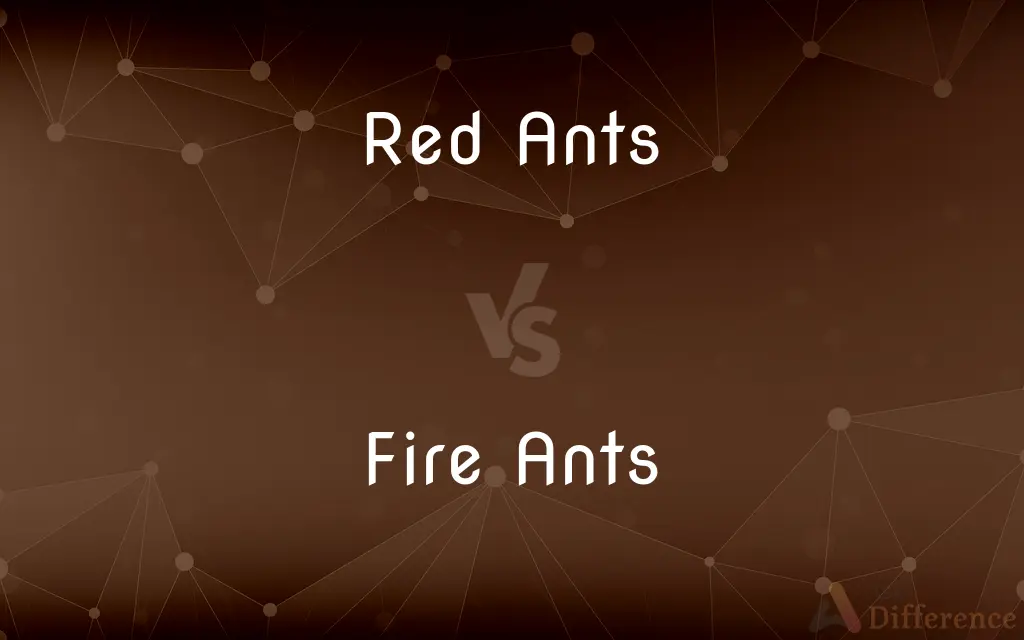Red Ants vs. Fire Ants — What's the Difference?
By Tayyaba Rehman — Published on November 19, 2023
Red Ants refer to various ant species with reddish-brown coloration; Fire Ants are a subset known for their painful sting and are typically more aggressive.

Difference Between Red Ants and Fire Ants
Table of Contents
ADVERTISEMENT
Key Differences
Red Ants encompass a broad category of ants that possess a reddish-brown coloration. This term is quite general and might pertain to numerous ant species across different regions. It's primarily a descriptive term, pointing to the ant's noticeable color but not specifically its behavior or other characteristics.
Fire Ants, in contrast, are a specific group within the Red Ant category, scientifically termed Solenopsis. They're particularly notorious for their painful sting which results in a burning sensation—thus the name "fire" ant. Originating from South America, these ants have since spread to various parts of the world and are considered invasive in many areas due to their aggressive nature and potential to outcompete native species.
While all Fire Ants can be considered Red Ants because of their color, not all Red Ants are Fire Ants. The distinction is significant, especially when considering the ecological impact and human interaction. Fire Ants, for instance, can pose threats to farming, wildlife, and even human health, unlike many other Red Ant species.
The names Red Ants and Fire Ants, though sometimes used interchangeably by those unfamiliar with the specifics, refer to distinct categories. Being precise with these terms is crucial, especially in areas where Fire Ant infestations are a concern, as treatments and management strategies differ based on the exact species present.
Comparison Chart
Definition
General term for reddish-brown ants
Specific group known for painful stings
ADVERTISEMENT
Origin
Generic term, no specific origin
Originated in South America
Behavior
Behavior varies by species
Aggressive, with painful sting
Ecological Impact
Varies by species
Often invasive, can outcompete native species
Relation to Other Terms
Broad category, includes many species
Subset of Red Ants
Compare with Definitions
Red Ants
Red Ants are ants with a reddish-brown hue.
Red Ants scurried around the picnic area, searching for food.
Fire Ants
Fire Ants are a specific group of Red Ants known for their sting.
The child learned to avoid Fire Ant mounds after experiencing a painful sting.
Red Ants
Red Ants can be found in various habitats.
From deserts to rainforests, Red Ants have diverse habitats.
Fire Ants
Fire Ants belong to the Solenopsis genus.
Researchers studied the behavior of Fire Ants in the Solenopsis genus.
Red Ants
They are primarily identified by their color.
The reddish tint of the Red Ants made them easily distinguishable from the black ants nearby.
Fire Ants
They deliver a sting that feels like burning, hence the name.
Stepping on a Fire Ant mound usually results in multiple painful stings.
Red Ants
Not all Red Ants are known for aggressive behavior.
Unlike some species, these Red Ants seemed rather docile.
Fire Ants
Fire Ants are considered invasive in many regions.
Efforts are being made to control the spread of Fire Ants in the southern U.S.
Red Ants
Red Ants can belong to various species and regions.
In the forest, we identified several different species of Red Ants.
Fire Ants
Their aggressive nature often disrupts local ecosystems.
Fire Ants can outcompete and reduce the numbers of native ant species.
Common Curiosities
Where did Fire Ants originate?
Fire Ants originated in South America.
Are Red Ants and Fire Ants the same?
While all Fire Ants are Red Ants, not all Red Ants are Fire Ants.
Why are Fire Ants an ecological concern?
They can outcompete native species, affecting biodiversity and ecosystem balance.
Are all Red Ants aggressive?
No, aggression varies among Red Ant species, but Fire Ants are notably aggressive.
Do all Red Ants sting?
Not all Red Ants sting; it depends on the species.
How can one treat a Fire Ant sting?
Clean the area with soap and water, apply a cold compress, and avoid scratching. Seek medical attention if allergic reactions occur.
How can one differentiate between Red Ants and Fire Ants?
Fire Ants have a notorious sting and are typically more aggressive than many Red Ant species.
What's unique about Fire Ants?
Fire Ants are known for their painful, burning sting and aggressive behavior.
Are Fire Ants considered invasive?
Yes, Fire Ants are invasive in many regions, disrupting local ecosystems.
How can one control Fire Ant infestations?
Using bait, treating mounds directly, and maintaining regular yard maintenance can help.
Do Red Ants have any beneficial ecological roles?
Yes, like other ants, they can aid in seed dispersal, decomposition, and control of pests.
What attracts Fire Ants to human habitats?
Food sources, moisture, and suitable nesting sites can attract them.
Are there multiple species of Fire Ants?
Yes, there are several species within the Solenopsis genus.
How fast do Fire Ant colonies grow?
Fire Ant colonies can grow rapidly, especially in favorable conditions.
Are there any natural predators of Fire Ants?
Yes, creatures like phorid flies, nematodes, and some birds prey on Fire Ants.
Share Your Discovery

Previous Comparison
Heat of Formation vs. Heat of Reaction
Next Comparison
Cloudiness vs. PrecipitationAuthor Spotlight
Written by
Tayyaba RehmanTayyaba Rehman is a distinguished writer, currently serving as a primary contributor to askdifference.com. As a researcher in semantics and etymology, Tayyaba's passion for the complexity of languages and their distinctions has found a perfect home on the platform. Tayyaba delves into the intricacies of language, distinguishing between commonly confused words and phrases, thereby providing clarity for readers worldwide.












































